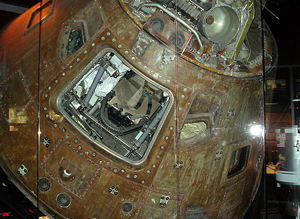ITAM: A Prerequisite for Building a CMDB (Part 1/6) - "Houston, we have a problem!"
This article series has been contributed by Peter Salfi at Provance.
In this series Peter explains why an Asset Registry, created within an IT Asset Management program, comprised of the appropriate mix of people, process and technology, is often an overlooked prerequisite to creating a CMDB.
It describes a less painful approach to creating a reliable and accurate CMDB that allows organizations to realize a high return on their investment in time, effort and expense.
- PART 1 – Introduction – “Houston, We Have A Problem!”
- PART 2 – The Link between ITAM and ITSM
- PART 3 – 4 Reasons Why ITAM is a Prerequisite for a CMDB
- PART 4 – Why Building a CMDB is challenging
- PART 5 – Summary of Comparisons – ITSM vs. ITAM
- PART 6 – Conclusion – “Back to the Apollo 13 Story”
Part One – Introduction – “Houston We Have A Problem!”
On April 13, 1970 an explosion on board the Apollo 13 spacecraft threatened the survival of the three-man crew. In a memorable scene from the 1995 motion picture “Apollo 13,” the flight engineers are presented with a box of “things” available to the astronauts on the crippled spacecraft. They are then challenged with configuring the available assets into something that will remove life-threatening carbon dioxide from the spacecraft and ensure the astronauts’ safe return.
The crew did indeed make it back to earth and the Apollo 13 mission was labeled a “successful failure!”
The Apollo 13 story is an apt metaphor that illustrates why IT Asset Management is an essential prerequisite for a Configuration Management Database, or CMDB. To understand why, it is important to establish some key concepts of IT Asset Management and Configuration Management, and determine why so many organizations find it challenging, expensive and time consuming to create a CMDB.
Assets, the Asset Registry, IT Asset Management and the CMDB
Assets are the things, such as hardware and software that an organization owns and uses in support of its day to day operations and in the provision of business services.
To effectively track the value of these assets and manage their use, it is also important to maintain additional information that describes them. An Asset Registry, as ITIL® (Information Technology Infrastructure Library) defines it, is the definitive trusted source for this inventory of assets (a straight forward list of what is owned) and the additional information to manage them. This additional information includes, but is not limited to purchasing records, support contracts, cost accounting, warranties, supplier information, license terms, leasing or rental agreements, physical location, ownership and assignment details. This information is typically scattered widely throughout the organization, found in separate and unrelated systems, files and documents.
The Asset Registry is synonymous with what is also often referred to as an “Asset Management Repository” or an “Asset Management Database.” It directly supports IT Operations and provides key decision-making information to multiple functions within an organization such as procurement, finance, governance, contract management and receiving. It is critical that the Asset Registry be comprehensive, accurate and up-to-date.
IT Asset Management is an organizational program that provides visibility and control of assets across their full lifecycle, from procurement to disposal. It is comprised of the appropriate mix of people, process and technology required to effectively manage assets and to capture, maintain and use asset information. IT Asset Management is essential to establish the accuracy and integrity of the Asset Registry. It supports decision making across multiple functions (i.e. finance, contract management, inventory management, procurement, etc.) to ensure optimized cost management of technology, the realization of desired return on investment (ROI) and the mitigation of security and compliance risks.
IT Asset Management technologies are critical enablers of an IT Asset Management program.
They provide:
- The facility to collect and maintain the information that makes up an Asset Registry by:
- Capturing contractual, financial, warranty, supplier, license, invoice, lease, geographic, ownership and assignment details;
- Reconciling and combining other sources of data in the Asset Registry with configuration scanning details; and
- Integrating with multiple disparate business systems (i.e. Procurement, Contract Management, Accounts Receivable and Payable, Human Resources and Receiving) allowing common and related data to be shared, utilized, leveraged and maximized.
- A single system to manage assets and assess their status through their entire lifecycle.
- Centralized capture of the many sources of information required to maintain compliance with software license terms and conditions.
- Preconfigured mechanisms supporting industry best practices for managing IT investments.
- Enforcement of process conformance and reduction of manual effort and human error through process automation.
- Data exports, reports and dashboards for operational and decision support.
- Integration and amalgamation of IT Asset Management and IT Service Management processes.
- Checks and balances to assure that the Asset Registry is complete, comprehensive, accurate and up-to-date for the effective and efficient management of IT investments.
Continues….
Read Part Two – ‘The Link between ITAM and ITSM’.
This article series has been contributed by Peter Salfi. To find out more about Provance IT Asset Management for Microsoft System Center visit Provance.
Can’t find what you’re looking for?
More from ITAM News & Analysis
-
Software Vendor Insights: What do the numbers tell us about the opportunities for ITAM negotiations?
What software vendor insights can be gained from the latest financial results from Amazon, Google, Broadcom, Salesforce, IBM and SAP? An important part of ITAM is paying close attention to the health of the companies we ... -
Flexera is first SAM tool vendor verified for Oracle E-Business Suite applications
Flexera has announced that it has been verified as the first software asset management (SAM) tool vendor for Oracle E-Business Suite applications. Almost anyone with an Oracle estate will be familiar with the company’s License Management ... -
ITAMantics - March 2024
Welcome to the March 2024 edition of ITAMantics, where George, Rich and Ryan discuss the month’s ITAM news. Up for discussion this month are. Listen to the full ITAMantics podcast above or queue it up from ...

